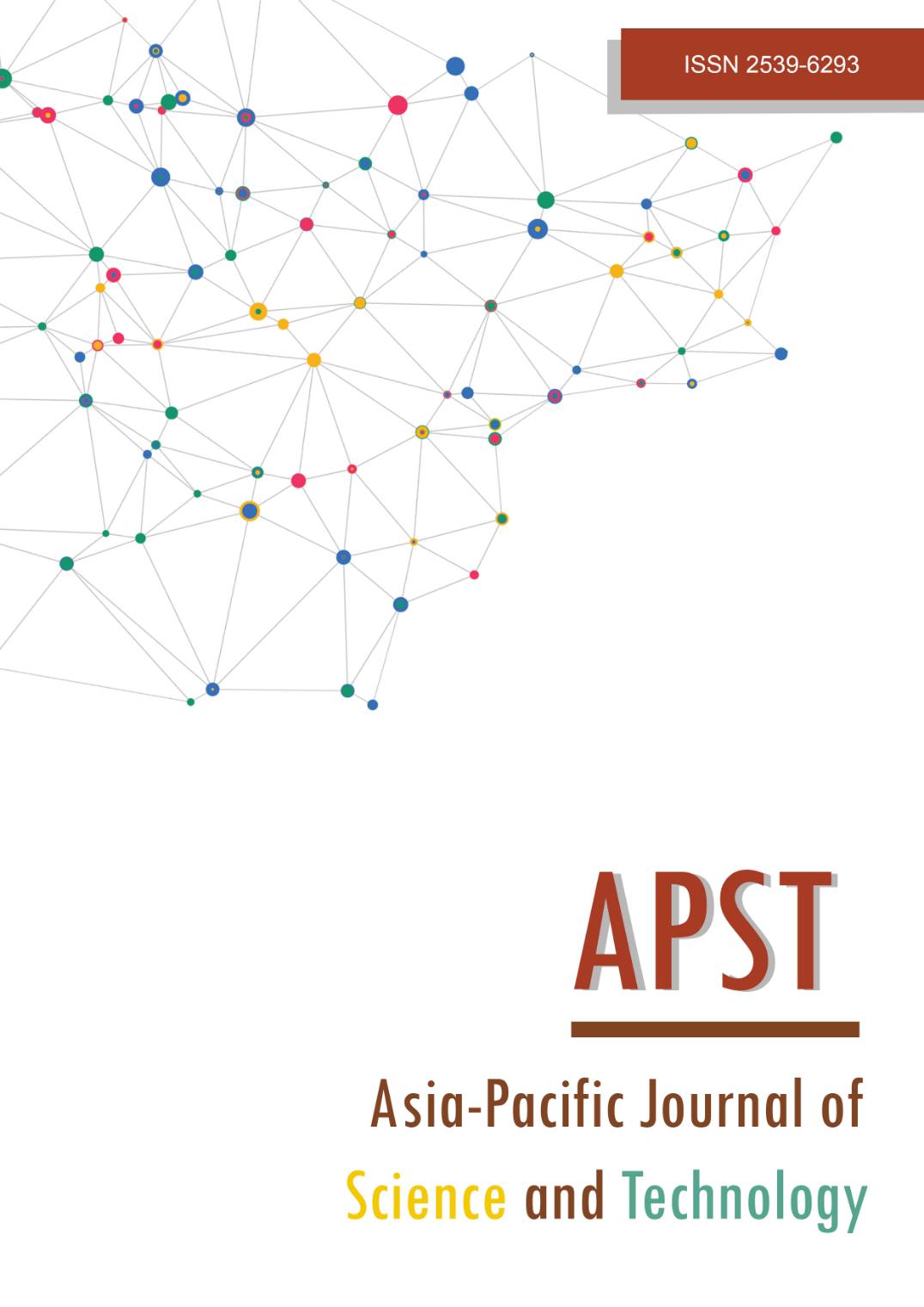Development of a geopolymer made from bagasse ash for use as a cementitious material
Main Article Content
Abstract
This research aimed to improve the properties of geopolymer made from bagasse ash. Bagasse ash, directly collected from disposed landfills, was burnt and ground to a higher fineness. Both original and re-burned bagasse ash were used as source materials, which were mixed with an alkaline solution to influence the geopolymer properties. Ordinary Portland cement (OPC) was applied to replace the bagasse ash between 5-15% by weight of the binder, and two methods of curing were observed. It was found that the re-burned bagasse ash tended to exhibit better compressive strength compared to original ash, and was compatible with both curing methods. The geopolymer from original bagasse ash, only with heat curing at 75 °C, exhibited useable compressive strength. The strength of geopolymer increased with an escalating amount of the OPC, whilst the workability was reduced. Geopolymer, which was made with OPC cured under moist conditions at room temperature, had an initial compressive strength that was lower than that with heat curing. However, this compressive strength was developed and became higher at a later age. From this study, the highest compressive strength of geopolymer produced from re-burned bagasse ash and blended with 15% of OPC was 49.9 Megapascal (MPa)at 90 days. In addition, geopolymer concrete displayedbetter abrasion resistance compared to the OPC concrete.
Article Details
References
Sung G, Bok Y, TaekK, Soo Y. The mechanical properties of fly ash-based geopolymer concrete with alkaline activators.Constr Build Mater.2015;47(2013):409-418.
Amran M, Debbarma S, Ozbakkaloglu T. Fly ash-based eco-friendly geopolymer concrete: acritical review of the long-term durability properties. Constr Build Mater. 2021;270.
Rukzon S, Chindaprasirt P. Utilization of bagasse ash in high-strength concrete. Mater Des. 2012;34:45-50.
Ganesan K, Rajagopal K, Thangavel K. Evaluation of bagasse ash as supplementary cementitious material. Cem Concr Compos. 2007;29(6):515-524.
Chusilp N, Jaturapitakkul C, Kiattikomol K. Utilization of bagasse ash as a pozzolanic material in concrete. Constr Build Mater. 2009;23(11):3352-3358.
Somna R, Jaturapitakkul C, Rattanachu P, ChaleeW. Effect of ground bagasse ash on mechanical and durability properties of recycled aggregate concrete. Mater Des. 2012;36:597-603.
Somna R, Jaturapitakkul C, Amde AM. Effect of ground fly ash and ground bagasse ash on the durability of recycled aggregate concrete. Cem Concr Compos. 2012;34(7):848-854.
Joshaghani A, Ramezanianpour AA, Rostami H. Effect of incorporating Sugarcane Bagasse Ash (SCBA) in mortar to examine durability of sulfate attack. In: Second International Conference on Concrete Sustainability;2016June13-15; Madrid, Spain. 2016. P. 576-596.
Heah CY, Kamarudin H, Mustafa Al,Bakri AM, Binhussain M, Luqman M, et al. Effect of curing profile on kaolin-based geopolymers. Phys Procedia. 2011;22:305-311.
Nath P, Sarker PK. Use of OPC to improve setting and early strength properties of low calcium fly ash geopolymer concrete cured at room temperature. Cem Concr Compos. 2015;55:205-214.
Suwan T, Fan M. Influence of OPC replacement and manufacturing procedures on the properties of self-cured geopolymer. Constr Build Mater. 2014;73:551-561.
ASTM. Standard test method for flow of hydraulic cement mortar. C1437. In: Annual Book of American Standard Testing Method. Philadelphia; 2005. p. 611-612.
ASTM. Standard specification for coal fly ash and raw or calcined natural pozzolan for use in concrete. C618-08a. In: Annual Book of ASTM Standards Concrete and Aggregates. Philadelphia; 2004. p. 335-338.
Yudenfreund M, Odler I, Brunauer S. Hardened Portland cement pastes of low porosity I. Materials and experimental methods. Cem Concr Res. 1972;2(3):313-330.
Li L, Chen M, Guo X, Lu L, Wang S, Cheng X, et al. Early-age hydration characteristics and kinetics of Portland cement pastes with super low w/c ratios using ice particles as mixing water. J Mater Res Technol. 2020;9(4):8407-8428.
Bahurudeen A, Santhanam M. Influence of different processing methods on the pozzolanic performance of sugarcane bagasse ash. Cem Concr Compos. 2015;56:32-45.
Montakarntiwong K, Chusilp N, Tangchirapat W, Jaturapitakkul C. Strength and heat evolution of concretes containing bagasse ash from thermal power plants in sugar industry. Mater Des. 2013;49:414-420.
ASTM. Standard test method for compressive strength of hydraulic cement mortars. C109/C109M-99. In: Annual Book of American Standard Testing Method. Philadelphia; 2004. p. 82-87.
Assi L, Ghahari SA, Deaver EE, Leaphart D, Ziehl P. Improvement of the early and final compressive strength of fly ash-based geopolymer concrete at ambient conditions. Constr Build Mater.2016;123:806-813.
Kaur M, Singh J, Kaur M. Synthesis of fly ash based geopolymer mortar considering different concentrations and combinations of alkaline activator solution. J Chem Inf Model. 1981;53(9):1689-1699.
Rashad AM, Zeedan SR. The effect of activator concentration on the residual strength of alkali-activated fly ash pastes subjected to thermal load. Constr Build Mater. 2011;25(7):3098-3107.
Thilakarathna PSM, Seo S, Baduge KSK, Lee H, Mendis P, Foliente G. Embodied carbon analysis and benchmarking emissions of high and ultra-high strength concrete using machine learning algorithms. J Clean Prod. 2020;262:3-5.
Chusilp N, Jaturapitakkul C, Kiattikomol K. Effects of LOI of ground bagasse ash on the compressive strength and sulfate resistance of mortars. Constr Build Mater. 2009;23(12):3523-3531.
Ribeiro DV, Morelli MR. Effect of calcination temperature on the pozzolanic activity of Brazilian sugar cane bagasse ash (SCBA). Mater Res. 2014;17(4):974-981.
Mehta A, Siddique R. An overview of geopolymers derived from industrial by-products. Constr Build Mater. 2016;127:183-198.
Pangdaeng S, Phoo-ngernkham T, Sata V, Chindaprasirt P. Influence of curing conditions on properties of high calcium fly ash geopolymer containing Portland cement as additive. Mater Des. 2014;53:269-274.
Huang CH, Lin SK, Chang CS, Chen HJ. Mix proportions and mechanical properties of concrete containing very high-volume of Class F fly ash. Constr Build Mater. 2013;46:71-78.
Chusilp,N., Jaturapitakkul, C,Kiattikomol K. Effects of LOI of ground bagasse ash on the compressive strength and sulfate resistance of mortars.pdf. Constr Build Mater. 2009;23:3523-3531.
Mehta A, Siddique R. Properties of low-calcium fly ash based geopolymer concrete incorporating OPC as partial replacement of fly ash. Constr Build Mater. 2017;150:792-807.
Ramujee K, Potharaju M. Abrasion Resistance of Geopolymer Composites [Internet]. New York: Curran Associates, Inc; 2014 [cited 2021 05 31]. Available from: http://dx.doi.org/10.1016/j.mspro.2014.07.230.


